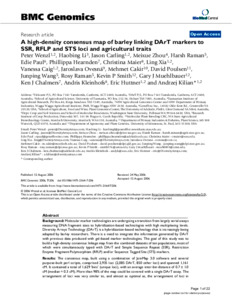Wenzl, P., Li, H., Carling, J., Zhou, M., Raman, H., Paul, E., Hearnden, P., Maier, C., Xia, L., Caig, V., Ovesná, J., Cakir, M., Poulsen, D., Wang, J., Raman, R., Smith, K.P., Muehlbauer, G.J., Chalmers, K.J., Kleinhofs, A., Huttner, E. and Kilian, A.
(2006)
A high-density consensus map of barley linking DArT markers to SSR, RFLP and STS loci and agricultural traits.
BMC Genomics, 7
(206).
![[img]](/1045/1.hassmallThumbnailVersion/A-highdensity-consensus-map-of-barley-linking-DArT-markers-to-SSR-RFLP-and-STS-loci-and-agricultural-traitsBMC-Genomics.pdf)  Preview |
|
PDF
1MB
|
Article Link: http://dx.doi.org/10.1186/1471-2164-7-206
Publisher URL: http://www.biomedcentral.com/
Abstract
Background:
Molecular marker technologies are undergoing a transition from largely serial assays measuring DNA fragment sizes to hybridization-based technologies with high multiplexing levels. Diversity Arrays Technology (DArT) is a hybridization-based technology that is increasingly being adopted by barley researchers. There is a need to integrate the information generated by DArT with previous data produced with gel-based marker technologies. The goal of this study was to build a high-density consensus linkage map from the combined datasets of ten populations, most of which were simultaneously typed with DArT and Simple Sequence Repeat (SSR), Restriction Enzyme Fragment Polymorphism (RFLP) and/or Sequence Tagged Site (STS) markers.
Results:
The consensus map, built using a combination of JoinMap 3.0 software and several purpose-built perl scripts, comprised 2,935 loci (2,085 DArT, 850 other loci) and spanned 1,161 cM. It contained a total of 1,629 'bins' (unique loci), with an average inter-bin distance of 0.7 ± 1.0 cM (median = 0.3 cM). More than 98% of the map could be covered with a single DArT assay. The arrangement of loci was very similar to, and almost as optimal as, the arrangement of loci in component maps built for individual populations. The locus order of a synthetic map derived from merging the component maps without considering the segregation data was only slightly inferior. The distribution of loci along chromosomes indicated centromeric suppression of recombination in all chromosomes except 5H. DArT markers appeared to have a moderate tendency toward hypomethylated, gene-rich regions in distal chromosome areas. On the average, 14 ± 9 DArT loci were identified within 5 cM on either side of SSR, RFLP or STS loci previously identified as linked to agricultural traits.
Conclusion:
Our barley consensus map provides a framework for transferring genetic information between different marker systems and for deploying DArT markers in molecular breeding schemes. The study also highlights the need for improved software for building consensus maps from high-density segregation data of multiple populations.
| Item Type: | Article |
|---|
| Corporate Creators: | Plant Science |
|---|
| Additional Information: | © Wenzl et al; licensee BioMed Central Ltd.
This is an Open Access article distributed under the terms of the Creative Commons Attribution License (http://creativecommons.org/licenses/by/2.0),
which permits unrestricted use, distribution, and reproduction in any medium, provided the original work is properly cited. |
|---|
| Keywords: | Linkage maps; Arabidopsis thaliana; Diversity Arrays Technology (DArT); Amplified Restriction Fragment Length Polymorphism (AFLP); Restriction Fragment Length Polymorphism (RFLP); Simple Sequence Repeats (SSR); Sequence Tagged Site (STS); genome; recombination; populations; tomato. |
|---|
| Subjects: | Plant culture > Field crops > Barley
Science > Biology > Molecular Biology
Science > Biology > Genetics |
|---|
| Live Archive: | 13 Jan 2009 01:57 |
|---|
| Last Modified: | 03 Sep 2021 16:43 |
|---|
Repository Staff Only: item control page

 PlumX
PlumX PlumX
PlumX